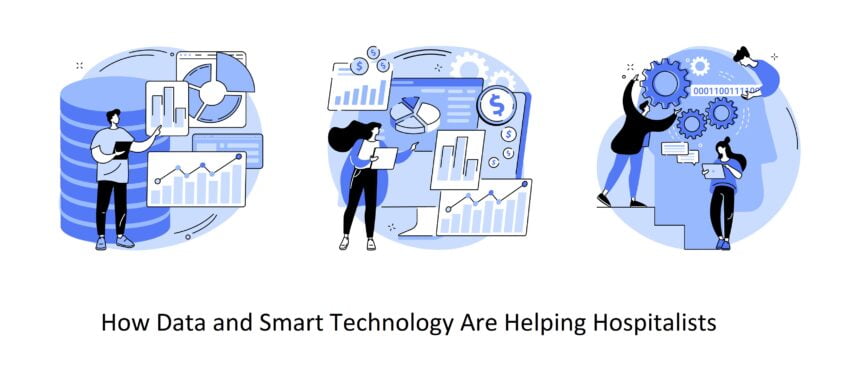Hospitalists face several challenges unique to their role. The increasing complexity of patient care, difficulties with time management, and managing administrative tasks while complying with regulations are a few overarching difficulties that go hand-in-hand with the job.
Fortunately, big data and smart technology are helping hospitalists overcome these issues. Here are some fascinating ways data and smart technology are helping hospitalists.
Improving Billing Processes and Accuracy
Medical billing is notoriously erroneous. Some estimates propose that upward of 80% of medical bills have errors. The Medical Billing Advocates of America have reported finding errors on 75% of accounts they review. Plenty of meaningful case studies on medical billing for hospital medicine also highlight the issues these errors cause for hospitalists.
Big data and smart technology are helping hospitalists improve billing accuracy in many ways. First, this innovative technology reduces the risk of errors. According to a study published in the Journal of the American Medical Association, electronic health records (EHRs) and other data-tracking systems can help reduce billing errors by up to 50%. Creating streamlined systems that centralize EHR, coding, and charge capture help hospitalists reduce errors in billing accuracy.
Another way big data and intelligent technology enhance billing accuracy is by providing hospitalists with more insights and analytics about their patient populations and workflows. These insights can help hospitalists track claim rejections, accounts receivable aging, and other metrics to create measurable improvement goals.
Improving Diagnostics Through Wearables
Big data, smart technology, and AI can help hospitalists efficiently and accurately diagnose and treat patients by analyzing data. Wearable technology has become a significant contributor to enhanced diagnostic methods. One study published in the Journal of the American Medical Association found that using machine learning algorithms to analyze medical images can improve the accuracy of diagnosis for certain conditions, such as breast cancer.
Wearable technology can help to improve diagnostics by providing hospitalists with more data about a patient’s health over time. This factor is beneficial in an acute care setting, as hospitalists lack the patient care history from a first-person perspective.
For example, wearable devices can track a patient’s activity levels, sleep patterns, and other health metrics, providing acute care physicians with a more comprehensive understanding of a patient’s health.
This data helps identify patterns and trends that indicate a need for further testing or treatment, allowing for more accurate diagnoses. Early diagnostics also create an opportunity to intervene early, improving patient outcomes and decreasing the costs associated with care.
Improving Patient Care Through Personalization
Big data and smart technology are helping medical professionals better understand and predict patient needs. This technology is assisting hospitalists in creating more personalized and effective treatment plans. The study mentioned above also found that using machine learning algorithms to analyze electronic health records (EHRs) can predict patient outcomes more accurately than traditional methods.
Data-driven personalization also allows hospitalists to tailor their treatment recommendations to an individual patient’s specific needs and health history rather than relying on a one-size-fits-all approach. Again, this factor is integral in an acute care setting.
Improving Productivity
Having the right tools in place can revolutionize how a hospitalist schedules their day. Using centralized tools that allow access to EHRs, progress notes, and billing reports can help a hospitalist improve their productivity without sacrificing the integrity of patient care. In fact, the more efficient and accurate they become, the better the quality of care.
Using AI-driven tools and smart software, hospitalists can quickly and easily access a patient’s medical history, minimizing the time spent searching for and reviewing paper records. EMRs also allow for more efficient communication between hospitalists and care teams, as they can easily share patient information with other healthcare professionals by clicking a button.
Smart systems are also helping acute care physicians streamline their workflow, freeing up time to focus on more complex tasks and seeing more patients. For example, a study published in the Journal of Medical Internet Research found that using electronic prescribing systems can reduce the time doctors spend on paperwork, allowing them to see more patients and improving the efficiency of their practice.
Improving Patient Safety
Big data and smart technology can be used to identify patterns in medication use that may indicate an increased risk of adverse events. Easy access to patient records and alert systems can also notify hospitalists of potential conflicts between medications. This can allow healthcare providers to make more informed decisions about which medications to prescribe, reducing the risk of harm to patients.
These various tech integrations can also help improve patient engagement and compliance. Streamlining workflows allows the hospitalist to interact more with patients and build a trusting rapport. Hospitalists can engage patients more effectively and encourage them to take an active role in their own care. This can lead to improved patient safety as patients are more likely to follow treatment recommendations and take necessary precautions to prevent adverse events.
Communication gaps are another overarching issue in patient safety and wellness. As hospitalists often juggle patients and facilities, reducing care gaps is paramount. Using centralized systems ensures everyone on the care team is up to date on what the patient needs.
Creating Continuous and Remote Monitoring
Wearable technology can be worn on the body to monitor various health metrics. As mentioned previously, this technology can help to improve diagnostics in acute care by providing hospitalists with real-time data about a patient’s health.
For example, wearables can continuously monitor a patient’s vital signs, such as heart rate, pulse abnormalities, blood pressure, and oxygen levels when the acute care physician isn’t present.
Final Thoughts
In conclusion, big data and smart technology are providing hospitalists with new tools and insights that are helping to improve patient care, productivity, diagnostics, and billing accuracy.
By leveraging these technologies, hospitalists can more accurately predict patient needs, streamline their workflow, improve the accuracy of diagnoses, and enhance the patient experience. These advances are helping to transform the healthcare industry, improving patient outcomes, and reducing the costs of care both in income loss for hospitalists and incorrect billing for patients.








